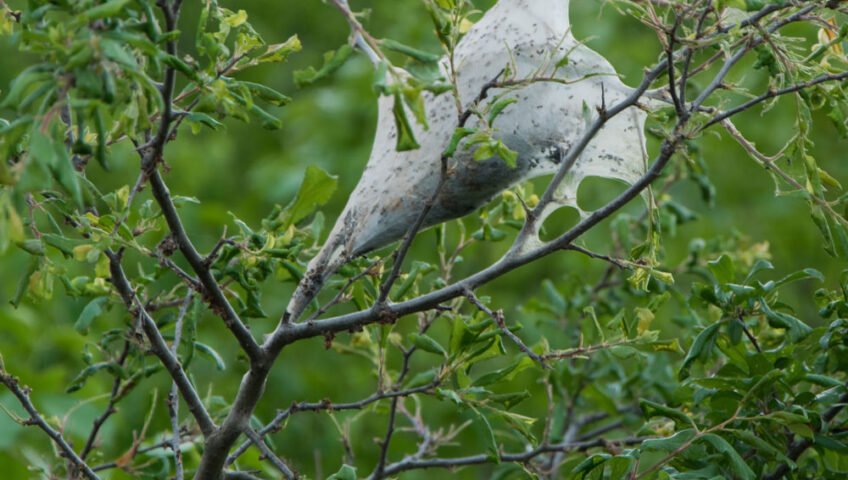Fall webworm is often nicknamed “tent caterpillars” because of the soft white nests (“tents”) that they build at the tips of the branches of infested trees.
Unfortunately, the tent caterpillars are not very picky about their host trees and will readily move into the leaves and limbs of more than 200 different varietals of trees and shrubs.
While the fall webworm isn’t shy about announcing its presence at the larval stage while building its protective tents, for most of the rest of the year it lurks mostly undetected in and around the host tree. So it can be quite a surprise for homeowners to suddenly witness the formation of their trademark silky web-like nests.
Understanding the Fall Webworm Life Cycle
As with many similar pests, understanding the tent caterpillar life cycle is an important key to effective lawn maintenance.
Tent caterpillars are called “fall webworm” for a reason – fall is when the worms typically reach maturation.
While the fall webworm typically isn’t fatal for an infested tree or bush, when garden maintenance is neglected it can affect the ornamental value of the tree. Over time, repeat infestations that are left untreated can weaken and even kill a host tree.
Winter and spring.
Winter is the dormant season for the fall webworm. While you might not see them while doing your normal lawn care, their cocoons are typically located right in the soil or leaf litter that surrounds the selected host tree.
They will stay inside their cocoons as they mature all throughout the spring.
Summer.
In the summer, the adults emerge from their cocoons at last and are ready to mate. After mating, the females will get to work laying their eggs on the leaves of the nearby host tree. Often the females will lay on the undersides of the leaves so they are harder to spot.
The larvae begin to hatch in a matter of days after the eggs are deposited. Immediately, the larvae begin to do two things: feed on the surrounding leaves and spin a web around themselves for protection. The more they eat, the bigger the web gets.
Fall.
Because the webs start out small, most homeowners don’t even realize they have an infested tree until late summer or even early fall when the caterpillars and their webs are much bigger.
Getting close to the webs can help make a positive identification. Fall webworm caterpillars are typically tan, green and pale yellow in color and are covered with small spiky fine white hairs.
What Are the Most Common Host Trees for Fall Webworm?
While fall webworm infestations have been documented on more than 200 tree and shrub species throughout the country, the caterpillars do have their favorites. The webworm feeds on the freshest and most tender leaf parts so their choice of host tree can also vary depending on when they hatch.
Cottonwood, redbud, elm, walnut, sweetgum, poplar, willow, crabapple, maple, hickory, birch and cherry trees are common targets for the fall webworm.
Many of the fall webworm’s favored host trees are also popular fruit and nut-producing trees. Without active and vigilant garden maintenance to protect these trees, the annual harvest may be reduced or destroyed by the fall webworm caterpillars.
Fall webworm may only breed once in some parts of the country, but may breed twice or more frequently in other parts of the country depending on climate and local weather patterns.
When to Treat Trees for Fall Webworm
While fall webworm does have natural predators, including birds and other insects, a single tree can often play host to multiple nests and each nest can contain hundreds of maturing caterpillars. So inevitably, some of the caterpillars will survive to overwinter and re-infest the following year.
The best time to schedule lawn maintenance to treat for fall webworm is when they are at their most vulnerable – in the larvae/caterpillar stage.
The best timing for lawn care treatment may differ depending on how early or late in the summer/fall season the caterpillars hatch. For best results, time the treatment when the webs are just beginning to form and the larvae inside are very small. In most cases, this will mean treating in early to mid summer.
How to Treat Trees for Fall Webworm
For very small and self-contained infestations, it may be possible to treat simply with judicious pruning. Because the webs are built at the tips of the branches, it is even possible to remove them manually from young trees. Pole trimmers can be useful to remove webs on higher limbs and branches.
A lawn care professional can examine the infested tree and decide whether this approach will be sufficient to guard against a re-infestation later in the year or the following year.
For larger infestations on a single host tree or developing infestations that are impacting multiple trees and/or bushes, it is typically best to apply insecticide directly to each web to treat the problem. Here again, this is slightly easier because of the location of the webs.
The best approach for chemical treatment is to spray the insecticide directly within the webs. This not only provides targeted treatment directly to the source of the problem but also guards against inadvertently damaging surrounding foliage and to beneficial insects, including natural predators of the fall webworm larvae.
As well, part of the protective nature of the webs is that they become somewhat water-resistant once established. The earlier the insecticide is applied to webs, the more easily it will penetrate to the interior to ensure none of the larvae survive.
While fall webworm is not likely to be the most damaging tree infestation most homeowners will face, persistent infestations can severely damage trees’ appearance and even kill young, fragile trees.
A lawn maintenance professional can be an important ally to preserve your home’s “curb appeal” and ensure small fall webworm infestations do not ever pose a serious threat.

